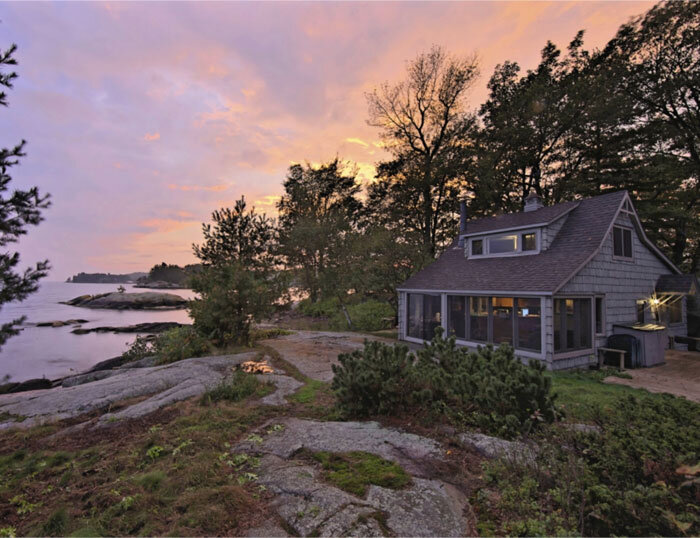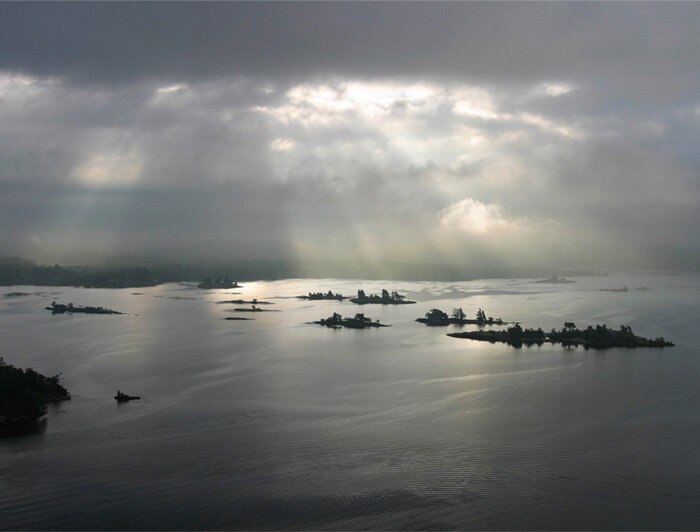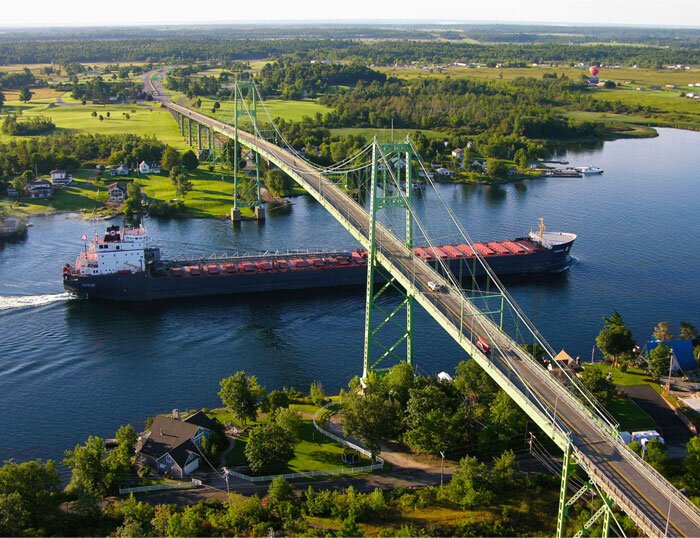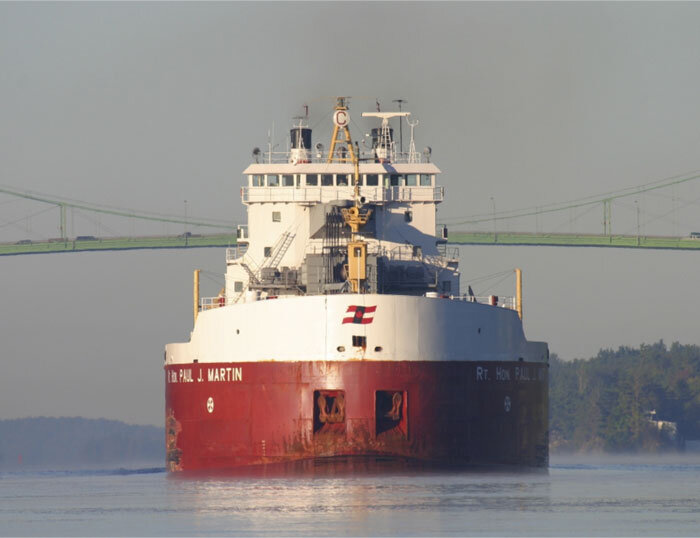THE PRIVILEGED VIEW
Ian Coristine is a passionate man, driven by beauty, excellence, meaning, emotions, friendship and his own, forever searching heart. In One in Thousand, he speaks with a voice flavoured with humour, love, longing and belonging. Through his eyes we see a world so deep in history and visual magic that we too feel the gravitational pull that holds him there. From an island he deems one in a thousand, Coristine, who is one in a million, takes you by the hand to a place you will not ever leave.
There are many things that make up the recipe for the heady cocktail that is powered or unpowered flight – history, technology, speed, brotherhood or perhaps the extreme test of human reflex and presence of mind that is aerial combat. But there is one key ingredient of all aerial endeavour and all childhood dreams of flight that has inspired aviators from Otto Lilienthal to Burt Rutan - the opportunity to view the world through the eyes of the eagle. The common denominator which binds together the souls of aviators around the globe with tendrils of cirrus cloud, the single uplifting vision we all have held true in our dreams, is the god-gift of soaring flight high above a world where gravity bound humans live in the other two planes of existence. To see beyond the horizon, to sense and process the true nature of geography, of man's footprint upon his home planet, to wheel and loop and joyfully exist in the space between the drudgery of our lives and the place we have always reserved for our gods - these are the first coals that are placed on the hearth of our passion for flight. John Gillespie Magee described this place better than anyone - the high, untrespassed sanctity of space.
While millions of humans fly every week, few feel that passion burning in the process, save possibly the two pilots at the front of the aircraft or perhaps a child with his forehead pressed against the window twenty rows behind them. While most of us pilots still feel the joy when our wheels reject the earth and the weight of our tribulations is borne by the wings of an airplane, few of us have truly been able to communicate to earthbound brothers and sisters this remarkable superpower, this gift of science, this privileged view.
Aviator, author and photographer Ian Coristine is one of the rare aviators with an ability to capture and share the magical, spiritual and often surreal benefits of a life spent soaring with the eagles.
Coristine has been an aviator for the past forty years, converting a truncated auto racing career into a new-found passion for gliding - soundlessly, motorlessly, effortlessly reaching for and living among the invisible currents of moving air. Coristine would cross over from gliders into the weakly-powered, experimental world that was the seminal years of ultralight flying in Canada. Spinning out of this newly found ability to fly under power and under $20,000, Coristine opened the first ultralight school in Canada, and became the Canadian distributor for the now-ubiquitous Quad City Challenger II ultralight - the tiny, unsophisticated, empowering home built aircraft that changed the face of general and recreational flying in this country.
When Coristine left the world of open wheel Formula auto racing behind, he needed a replacement fix for the thrills, precision and personal challenge. He found that in high performance gliding, a sport that was alive and well in his native Quebec . Here we see him in the cockpit of his club's sailplane at a meet. Photo via Ian Coristine
The young and clearly delighted flyer soon moved on to powered flight in the form of the first generation ultralight known as the Lazair - powered by two six-horsepower chainsaw engines. Photo via Ian Coristine
The eventual positive progress of ultralight design lead to the ubiquitous and beautifully flying Quad City Challenger II ultralight. Like no other aircraft in the past 25 years, the Challenger was the saviour of recreational flying in Canada - providing an easy to purchase, easy to build, easy to maintain and easy to fly substitute for the increasingly expensive and increasingly regulated world of Cessnas and Pipers. C-IBPP, Coristine's personal Challenger became the symbol of that paradigm shift to ultralight fun.
Related Stories
Click on image
For 20 years, Coristine travelled the width and breadth of eastern Canada and eastern United States like a combination traveling salesman, barnstormer and evangelical preacher, demonstrating the amazing flying characteristics of that wonderful little fabric covered airplane. Along the way, he discovered three things - an ability to fly his Challenger that was second nature to him, a love for photography and a place on the surface of the Earth so breathlessly beautiful that it drew him and his airplane in like a moth to a flame.
As was his passion, Coristine would from time to time round up a few of his flying friends and together they would set out on a flying adventure with no plan other than to follow a river, a road or a vee of Canada geese, allowing whim and serendipity to light their way. On one such trip, the aviators found themselves flying along the St. Lawrence river heading west and towards the historic city of Brockville, with the sun at their backs. What transpired next, would alter the course of his life for ever more.
The sparkling beauty of the region known as the Thousand Islands, with its flagged pines, its rocky islands pushing their bleached backs up out of the water to warm in the sun, and its fabulous island mansions caught his imagination like no other place he had ever been to. After several visits to explore the endless bays, beaches, lighthouses and castles, he found an island which, with some fiscal stretching, he acquired as his own insular fiefdom– an island paradise called Raleigh Island that offered everything from radiant sunsets to Aboriginal provenance to float plane shelter. From that point on, all his days, all his nights, all his vexation and jubilation, all his aerial adventures, all his creative release led him to the inevitability that is the e-book called One in a Thousand.
Created by nature during the last ice age with float planes in mind, Raleigh Island has it all - pine stands, exposed Cambrian Shield, delightful anchorage, and excellent views up and down the river. Photo: Ian Coristine
Coristine's Raleigh Island was truly “One in a thousand” - with a protected aircraft harbour and enough space to make every day on the island a unique experience. Photo: Ian Coristine
Raleigh Island was and remains today a paradise for Coristine, a front row seat at the ever changing drama that is the Thousands Islands, and a source of pride, satisfaction and creativity. Gone today is Coristine's airplane, replaced by quite pedal-kayaks and swift power boats that carry him to his future. Photo: Ian Coristine
There is room for visiting pilots in the protective harbour of Raleigh Island. Photo: Ian Coristine
Coristine has always worked without a net. His success comes largely from his willingness to take risks, do what others won't or can't and tweak and tune his creation until every ounce of creativity and performance has been wrested from its guts. Ian Coristine has never followed, never punched a clock, never sacrificed his ideals or collected an indexed pension, but he has spent 30 years providing for his family by simply selling his energy and his skills and a promise to his ultralight clients that life is beautiful, if only you reach out and embrace it. It was a sales pitch he lived always.
Coristine's new book is far more complex and layered than just another story about an aviator, but this is the way you are drawn to his story and to his island. The book opens with a video introduction, narrated in his own passionate voice and is the best way for you to understand what the book is all about. If you click on One in a Thousand - Video Intro, you will see what I mean. Set to full screen, turn up the volume and if this video does not make you want to spend the $8.99 to see how it ends, then you need to see a cardiologist. When you do buy it, take a moment to rate it... the world needs to see this book.
What follows is a small sampling of images by Coristine that appear in the book... there are more than 400 more. If you want to see how the technology works, check out this video which gives you an excellent idea of the depth and multiple layers which make up this remarkable memoir and iPad app.
Coristine's images long ago caught the eye of France's DxO, a digital photography image enhancement software company. Widely considered the most sophisticated and best way to wring the perfection out of any image a pro can create, DxO aligns themselves with only a few of the world's finest shooters, or DxO Image Masters as they are known. Ian is one such Master and on their website you can see another video about the book and the man. If you own an iPad, and truly want to understand the book potential that lies within it, I highly recommend you spend the small price to get this "ground breaking book”. I would go so far as to say it might even be worth buying an iPad for that reason alone.
Here is a quick way to find and purchase the app... just visit the website: One in a Thousand and click on the App store icon
The electronic “Cover” of One in a Thousand - Ian Coristine's spectacular new e-book memoir. One in a Thousand, available only for the i-Pad, cannot be found in the e-books section of the i-Tunes Store. It is so full of innovative technology, interactivity, videos, and slide shows that it is in fact an “App”, available by going to your Apple App Store. One part Mosquito Coast by Paul Theroux, one part A Year in Provence by Peter Mayle and one part Canada – A Year of the Land, One in a Thousand is a deal, nay, a steal, at only $8.99 from the App Store. From the moment you “open” this book, you, like Coristine was, are going to be transported to a world you couldn't even imagine. The book contains, more than 300 pages written by Corsitine and edited by American novelist Donna Walsh Inglehart, supplemented by over 450 of his finest images, slideshows, more than 20 minutes of breathtaking aerial videos, two music videos by Canada's meteoric new indy band, Great Lake Swimmers, plus 18 never before released instrumental tracks written by Great Lake Swimmers especially for the book.
After his wife Louise died in 1904, George Boldt abandoned his castle and the residence began a seventy-year decline to wrack and ruin. thanks to the vision of the Thousand Island Bridge Authority, it was rescued from the fate the claimed many of the other mansions of the gilded age scattered through the islands. Photo: Ian Coristine
At the turn-of-the-century, George C. Boldt, millionaire proprietor of the world famous Waldorf Astoria Hotel in New York City, set out to build a full size Rhineland-style castle in Alexandria Bay, on picturesque Heart Island. The grandiose structure was to be a display of his love for his wife, Louise. Back in the day, there was very little electrical power available to the millionaires who built their castles on the St. Lawrence, so Boldt Castle had its own power generating station, seen here at the extreme left of the island. Coristine, able to launch on the lake in early morning light, captures a freighter churning downstream past a stunning apparition. Photo: Ian Coristine
Predawn takeoffs make it impossible to know if the light or mood will cooperate, but mist on this particular morning offered promise. As daylight grew, Coristine was dismayed to find most of the River smothered in fog. He persisted and eventually the sun burned through at exactly the right place - Heart Island. Photo: Ian Coristine
Bathed in golden morning light, Boldt's castle emerges form the island's trees with the massive Boldt Castle Boat House in the background. Photo: Ian Coristine
The millionaires who constructed their lavish castles on the islands of the St. Lawrence have all vanished and with them most of the great residences they built. Only a few still exist and are now operated by foundations or private companies as tourist destinations. The original builders lived in a world before income tax and the great depression when businessmen kept every cent of a dollar they made. Most castles were abandoned to the elements or demolished when descendent family members could not keep them up. Here we see, from a unique perspective, the restored power station that supplied electricity to Boldt's magnificent summer home when it was not readily available to the community at large. The tower to the left held a carillon with fifteen bells ranging in size from twelve to fourteen feet and was intended to be played from a keyboard inside the main residence. Photo: Ian Coristine
The two crown jewels in the Thousand Islands are Boldt castle and Singer Castle seen here on Dark Island. The magnificent residence was built by Frederick Gilbert Bourne. Bourne was Director and President of the Singer Sewing Machine Company at the young age of 38. He was the man who oversaw the innovative idea of financing a purchase of a Singer machine through multiple payments of a dollar a week and this put Singer ahead of the competition and made Bourne very wealthy. Perhaps Bourne's greatest contribution to the growth and impact of the Singer Company was his commitment to advertising, creating a stand-alone advertising department in 1889 which was extremely creative and effective, setting the standard for the companies that followed. But Bourne was too ambitious to stay Singer president very long. He leveraged his position to become one of the wealthiest and best-connected men in America, a neighbour of the Vanderbilts and a close friend of Teddy Roosevelt. Bourne also held the position of Commodore of the New York Yacht Club. Photo: Ian Coristine
Coristine is as good on the water as he is in the air. Half of the photographs in his previous 5 print books and this e-book are taken from the perspective of a man who lives on the water even more than he lives in the air. Photo: Ian Coristine
A Canada Steamships laker gently plows past Three Sisters Island midstream in the St. Lawrence River. Recognizing from the air the opportunity to capture this technology-mimicking-nature shot, Coristine landed on the river and waited for MV Atlantic Erie, a Canada Steamships “self-unloader” laker, to come further down the channel. Then he took off and circled until they were aligned. Photo: Ian Coristine
Photos sometimes just happen. While circling in his aircraft for a better angle on Singer Castle on Dark Island, he found this heavenly image waiting for him at his six o'clock position. Photo: Ian Coristine
Coristine was flying in formation with a photoship, filming material for The History Channel's Things That Move series, when these light rays broke through heavy cloud over the Lake Fleet Islands. The frustrated cameraman in the second Challenger could not understand why Coristine broke formation and bolted west. Afterwards, when he saw the shot Coristine had captured, he understood. The Lake Fleet Islands are named for Great Lakes Fleet ships of the Royal Navy of Revolutionary War era, and have decidedly different names- Bloodletter, Deathdealer, Dumbfounder, Astounder, Scorpion and Axeman Photo: Ian Coristine
Not every perspective is from down low. Here Ian climbs high in the morning light to capture a wide shot of Wolfe Island the largest of the more than one thousand of the Thousand Islands. Photo: Ian Coristine
On August 14,1760, England's HMS Onondaga was lured into labyrinth of islands and channels by French attackers. A small boat with 14 men was lowered to warn sister ship HMS Mohawk away, but was never seen again. The place became known as the Lost Channel ever since. Brigantine Fair Jeanne in this photo has the benefit of an experienced captain and charts to help them navigate the still-endless maze. Photo: Ian Coristine
A cold river running to the sea is a living breathing animal, filtering and percolating through an archipelago of pre-cambrian islands and awakening almost daily beneath dissipating veils of sea smoke, fog, and mystic flows. Photo: Ian Coristine
The quiet town of Clayton, New York, home of the Antique Boat Museum wakes as a big grain carrier laker churns upstream in the morning sunlight on a windy morning. Photo: Ian Coristine
At the southwestern end of the Thousand Island region lies the Empire Loyalist city of Kingston. Once shortlisted for the capital of Canada, Kingston, nicknamed the Limestone City, is the home of the Royal Military College of Canada, Canada's university for the Armed Forces... sort of Annapolis, West Point and the Air Force Academy all rolled into one. Here Coristine flies over Old Fort Henry in the foreground with Navy Bay and the college peninsula in the mid-ground and Kingston beyond. Photo: Ian Coristine
There's a reason they call it The Thousand Islands. Through this region, the massive outflow of the great Lakes is filtered on its way down the mighty St. Lawrence River, Photo: Ian Coristine
The first deep freeze of the season turns the surface of the River into a boiling cauldron of sea smoke as the first skim of ice solidifies over the water. Photo: Ian Coristine
To qualify as an island, a rock or shoal supposedly has to be home to at least one native tree and be above water all year round. Lone Pine Island, looking like some Civil War era ironclad, has had extensive cosmetic work done to increase the livable space. Ever since viewing this image I have been tempted to Photoshop a wake behind the island. Photo: Ian Coristine
Large or small, every island in the 60 mile archipelago has its charm. Here, perched out over a jutting rock is a guest house worthy of some great memories. Photo: Ian Coristine
It is well known that the St. Lawrence River and the Thousand Islands region offer the finest fresh water wreck diving in the world – dotted with wrecks as they are from as far back as the War of 1812. Here, beneath the shallow waters of a Grenadier Island bay, lie the conjoined wrecks of two wooden cargo boats, the Pentland and the F.A. Georger. Photo: Ian Coristine
The Canadian Span of the Thousand Island Bridge leaps and bounds through the leafy islands of the archipelago on a suspension bridge followed by a steel arch bridge and a truss bridge. Photo: Ian Coristine
As this photo and the proceeding one attest, the morning and late evening provide the best opportunity to find that elusive magic light that makes a photographer's heart rate go up. Here, as the sun dips below the horizon, Coristine finds one such moment near the Canadian Span. Better get home Mr. Coristine, it's getting late. Photo: Ian Coristine
With a road deck 150 feet above the surface of the river, the US Span of the Thousand Islands Bridge was designed to allow high masted military ships to transit to the Great Lakes. The St. Lawrence Seaway, the water highway that would allow this was merely a concept at the time. The US Span lies well into American territory and Coristine would have to be flying low, slow and a mile inside US territory. Today, thanks to Al Queda, this would be inconceivable. Photo: Ian Coristine
Coristine says, “If this image came with a sound track, you'd be listening to the deafening bellow of this ship's foghorn waking the river, which the helmsman in the centre window of the bridge is blowing aggressively"... at Coristine's low flying and on-coming ultralight. Photo: Ian Coristine
Daybreak in the late fall occasionally finds the River cloaked in “sea smoke” as the water releases summer's accumulated warmth into suddenly colder air as though preparing these Chippewa Bay Islands for Halloween. Photo: Ian Coristine
A restful spot for an overnight anchorage in the Thousand Islands is disturbed by the Challenger's Rotax engine as Coristine circles at sunrise. The Canadian Empress, out of Kingston, is the only ship that offers this overnight service in the Thousand islands. She is often occupied by folks who have done the trip many times - a testament to the service and the appeal of the region. Photo: Ian Coristine






































